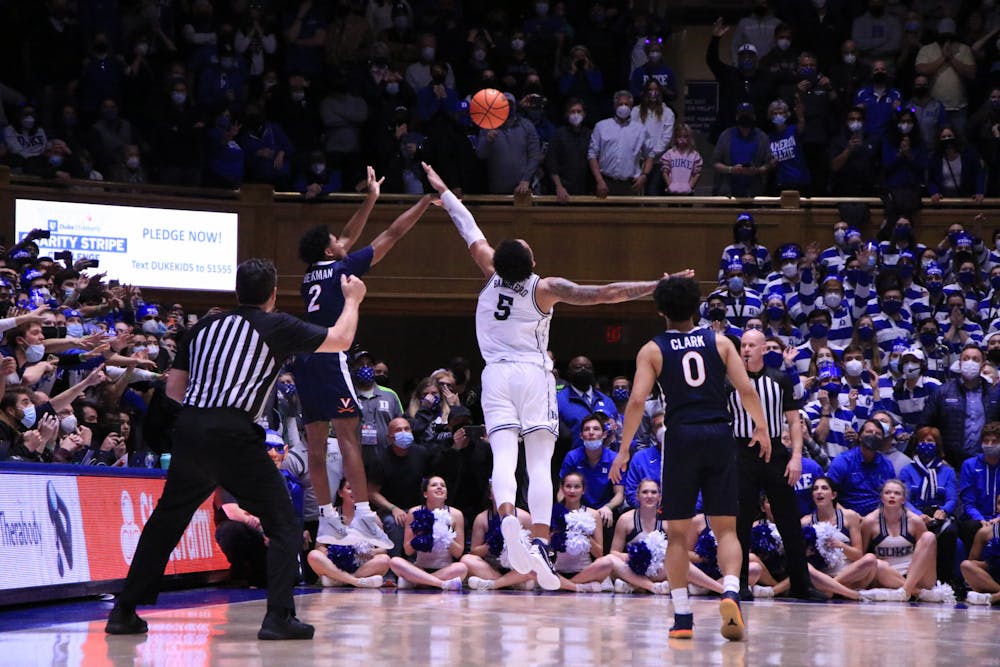After trading schematic blows for nearly 40 minutes, Duke finally had the upper hand. It thought it had the perfect weapon to slay the Cavaliers. It turned out the Blue Devils were gripping tightly to a double-edged sword.
No. 7 Duke lost 69-68 to Virginia on Monday, losing on a catch-and-shoot three from combo guard Reece Beekman with 1.1 seconds left. The Cavaliers had come out with a perfect game plan for the Blue Devils, and led from the first half through nearly the final four minutes of the game. Duke’s coaching staff was no slouch, though, and adjusted to take firm lead across the next four minutes. The problem was, Virginia responded in kind.
The Blue Devils actually turned away Virginia’s first attempt at the baseline-out-of-bounds perfectly; their sudden switch-everything defense completely flustered the Cavaliers’ cuts that were built to attack a zone. Plus Duke head coach Mike Krzyzewski had center Mark Williams guard the inbounder to make their life that much harder. Virginia head coach Tony Bennett had to call a timeout.
“They threw Mark on the ball, and that's tough for anybody. And we weren't sure; we had a zone call and a man call,” said Bennett. “So we [went ahead and] called the timeout. [Associate head coach Jason] Williford drew up a man-to-man play…it wasn't a broken play, we just didn't have a shot, touch the paint, kick. And the guys made a play out of it where we didn't get a clean look.”
The inbounding Beekman barely got the ball past the wingspan of Duke big wing Paolo Banchero. Except this meant Williams, the big man, was technically responsible for the 6-foot-3 Beekman. That’s an abnormal matchup for Williams, who initially moved to trap the new ball-handler before being called off by Banchero. Williams then saw Roach fighting with Cavalier center Kadin Shedrick, leading Williams to look for another assignment near the paint. Only there was no such assignment, because the open man was the combo guard leaking off the baseline late and flying open at the break.
“That was on me; I lost Beekman,” said Williams. “I should have stayed with him off the inbounds, and he got an open look and knocked it down…. I just lost him. Nothing else to it. It's on me, I take full responsibility for it.”
“We try to switch everything [while the ball is inbounded],” said Duke combo guard Trevor Keels. “I think somebody got caught up—probably a lack of talk. But we shouldn't have even been in that situation if everybody, including myself, played with that attitude, played harder.”
The Blue Devils had Virginia flustered on the first inbounds because of their biggest adjustment of the night: eschewing their base man defense for their 3-2 zone. The zone has worked in spurts this season, often looking good in spite of opponents making some tough shots against it.
Against the Cavaliers, Duke was forced to turn to the 3-2 because Virginia was killing it in two-man off-ball games. The Cavaliers came out with a concerted effort to stay away from the middle of the court, where Roach and wing Wendell Moore Jr. patrol, both rated as “excellent” defenders by Synergy. Instead, Virginia ran baseline lopps and curls and high flares to get the ball to its combo guards and wings on the move, with defenders like Blue Devil wing AJ Griffin and combo forward Joey Baker already behind their assignments when they received the ball. From there, it was just a matter of forcing those defenders to fight through another screen, and suddenly the Cavaliers had open lanes.
Duke had a couple ways it could’ve responded. The default was having centers Williams and Theo John shifting to drop coverage once their man turned into an off-ball screener; this meant that the rim was fairly protected, but that the ball was close to the cup by the time the big men were the primary defenders. Another option was aggressively hedging; the Blue Devils trying this mostly resulted in Cavalier-advantaged drives against closing defenders. The last two-man option was having the big man switch; the problem is that we’ve seen what happens when Duke lets its centers get pulled away from the rim against Florida State and Clemson.
So Duke turned to the zone, which Synergy reports as having been used 5.3% of the time this season. The zone is worse on a per-possession basis by about 0.08 points—good for a drop from the 94th percentile to the 62nd, which is still quite good. And it’s bound to be less effective, given that the team turns to the zone when its man scheme is ineffective in the first place.
Along with Williams’ interior play, Keels’ rim pressure, an all-around excellent evening for Roach, and a notable John game, the 3-2 negated Virginia’s initial game plan and made the Blue Devils the aggressors and the Cavaliers the reactors. And that meant Virginia, with one play left to run, had to be prepared for both Duke’s zone and its man coverage. The Blue Devils, however, were not equally prepared to run their zone and their man.
“Stay with your man,” said Krzyzewski. “You just gotta do what you have to do. And it's not complicated. At the end of the game, that was not complicated. That's not complicated.”
Get The Chronicle straight to your inbox
Signup for our weekly newsletter. Cancel at any time.

